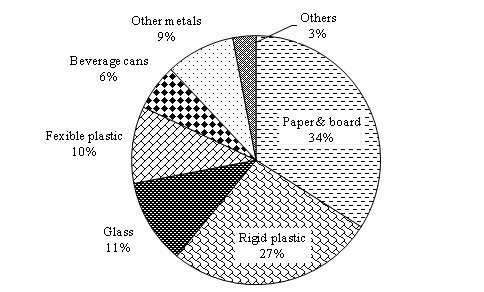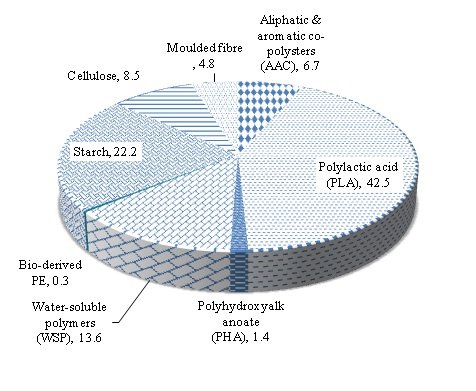Sustainable green packaging is now-a-days a most talked term which is used for materials that have low or negligible impact on the environment and also on public health. Packaging has become an indispensable part of our daily life as proper packaging allows food protection from physical, chemical or microbiological contamination. It also plays a vital role in preservation of food quality, minimizing food waste and reducing preservatives used in food. Any compromise with the packaging leads to health hazards by contamination.
One of the most momentous applications of plastics is in food packaging sector which first introduced in 1957 as a simple sandwich bag. Plastic food packages (PFPs) occupied over 25 to 30 percent of the bread packaging market in 1966. PFPs rapidly became popularized commercially since 1980due to its combination of flexibility, strength, lightness, stability, impermeability and ease of sterilization.Lately, ithas replaced all traditional food bags.
PFP does not affect the taste and quality of the foodstuff. In fact, the barrier properties of plastics ensure that food keeps its natural taste while protecting it from external contamination. Moreover, its unparalleled versatility is demonstrated in a multitude of applications.PFP hygienically protects and preserves perishable food for longer maintaining the taste and nutritional value of food.
Numerous forms of PFPs are broadly used in the world such as polythene bags, wrapping, bottles, rigid containers, caps and lids. From airtight wraps to shelf stable bottles and containers, plastic packaging plays a key role in delivering a safe food supply, from farm to table and is a material of choice for freezing food for longer term storage. Besides, modified atmosphere packaging helps to preserve food freshness and can extend a product’s shelf life by slowing the growth of bacteria.
The major types of plastic resins used in PFPsarepolyethylene terephthalate (PET), high-density polyethylene (HDPE), polyvinyl chloride (PVC), low-density polyethylene (LDPE), polypropylene (PP), polystyrene (PS) and polycarbonate (PC). Among them, PET is lightweight plastic that is made to be semi-rigid or rigid which makes it more impact resistant, and helps protect food. HDPE is a hard, opaque plastic that is lightweight but also strong.PVC is a common type of plastic that is biologically and chemically resistant. LDPE is thinner than some other resins and also has high heat resilience.PP is somewhat stiff but less brittle than some other plastics.PS is a colorless, hard plastic without much flexibility.
In food packaging,PET is commonly used for soft drinks, sport drinks, single-serve water, ketchup, salad dressing, vitamins, vegetable oil bottles and peanut butter containers.HDPE is used for juice and milk jugs, squeeze butter and vinegar bottles, and chocolate syrup containers, as-well-as grocery bags. PVC is used as packaging for tamper-resistant over-the-counter medications, along with shrink wrap for a variety of products. LDPE is used to make coffee can lids, bread bags, six-pack soda can ringsincluding fruit and vegetable bags.PP is used to make yogurt containers, maple syrup containers, cream cheese containers, sour cream containers, and prescription drug bottles.PS is used to make plastic cups, deli and bakery trays, fast food containers, lids, hot cups and egg cartons.
The PFP service life length is very short and so a large volume of discarded PFPs are generated daily. But PFPs are non-biodegradable and contain toxic chemicals such as BisphenolA (BPA), phthalates and PVC.Furthermore, toxic heavy metals such as lead, chromium, cadmium and mercury are added in PFPs as additives.Food contact of such toxic chemicals of PFPs contaminates packed food and ultimately creates consumer’s health hazards.Lack of degradability and the closing of landfill sites as-well-as growing water and soil pollution problems associated with discarded PFPs have led to concern about plastics.
In recent years, biofibers have attracted increasing interest due to their wide applications in food packaging. As a result, several types of biopolymers have been invented worldwide; such as polylactide (PLA), poly(hydroxybutyrate) (PHB), and poly(hydroxyalkanoate) (PHA) that are increasingly becoming available for use in food packaging. Again, PHB has several polymer classes – P3HB, P4HB, PHV, PHH, PHO, and their copolymers which quality is almost same as polyethylene (PE), PP and PS.
The most important bio-based plastics on the market are the PLA produced from Nature Works (USA) and the Mater-Bi, a starch based bioplastics, made from Novamont (Italy). Compostable plastic materials, produced from PLA, corn starch, or sugarcane degrade in a green yard-waste compost environment. PHA has attracted attention as environmentally friend alternatives to the synthetic polymers that are commonly used. PHAs are polyesters that produced and accumulated in intracellular granules by many microorganisms and can be produced by fermentation of renewable feedstocks (e.g., oil palm biomass).
From 2010 bioplastic technology is expected to change with the commercialization of bioplastics produced directly by natural/genetically modified organisms and the introduction of non-biodegradable, bio-derived PE. SmithersPira expects these materials will account for a quarter of total bioplastic packaging market demand by 2020. Traditional bioplastic packaging technologies based on starch, cellulose and polyester are each forecast to show a decline in market share to 2020.
United Statesbioplastics producer Cereplast launched a range of all-natural algae-based resins by the end of 2010. Also, several companies are exploring the development of bioplastics using carbon dioxide as a raw material. The potential for a process that converts waste carbon dioxide into a useful product is huge, but whether the material produced using this technique will prove commercially viable will ultimately depend on whether these new polymers are cost effective to produce.

Bioplastics can be a healthy and sustainable material in lieu of traditional plastic as 100% degradable, equally resistant and versatile. However, the chemical analysis of bio-plastic showed the presence of several chemical elements with large variability of mass fractions that indicates these plastics receive additives and may have been contaminated during manufacturing process and thereby has become potential environmental pollutants.
In Bangladesh,the plastic industry began its journey as a small industry in 1960. Then manufacture of plastic bags or packages was started in 1980. The average per capita plastics consumption is 5 kg per yearin Bangladesh. A significant quantity of it is used food packaging. Still, PFPs are not widely used in Bangladesh; therefore, government should take proper steps to encourage industries using organic source-derived food packages. Furthermore, the stringent regulations should be formulated and ensured regular monitoring of food packages and its additives contents.
The writer is studying B.Sc. (Hons.) in Microbiology at University of Chittagong.
Thanks for posting this, plastics are a real problem especially bags in Ghana. I'll now be looking out for PLA & PHA along with the companies which produce them also hope they can be adopted by mainstream!
Downvoting a post can decrease pending rewards and make it less visible. Common reasons:
Submit
Your are welcome, for understanding the problem.
Downvoting a post can decrease pending rewards and make it less visible. Common reasons:
Submit